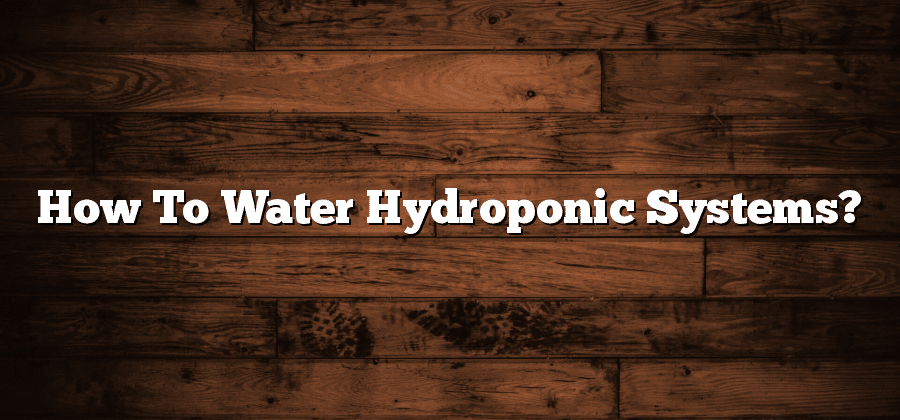Understanding Hydroponic Watering Techniques
Hydroponic watering techniques play a crucial role in ensuring the success of your hydroponic garden. Unlike traditional soil-based gardening, hydroponics relies on water as the primary medium for delivering essential nutrients to plant roots. The goal is to create an optimal environment where plants can thrive and grow rapidly.
One commonly used watering technique in hydroponics is the nutrient film technique (NFT). In this system, a thin film of nutrient-rich water flows continuously over the plant roots, providing them with a constant supply of oxygen, water, and nutrients. This method is highly efficient and allows for maximum nutrient absorption by the plants. Other popular techniques include ebb and flow, drip irrigation, and aeroponics, each offering its own unique advantages in terms of water distribution and nutrient delivery.
Choosing the Right Watering System for Hydroponics
Hydroponics is a method of growing plants without soil, where nutrients are supplied through water instead. One of the key aspects of hydroponics is choosing the right watering system to ensure optimal growth and health of the plants. There are various watering systems available for hydroponics, each with its own advantages and considerations.
One common watering system used in hydroponics is the drip system. This system involves delivering water and nutrients directly to the plant’s root zone through small tubes with drip emitters. The drip system allows for precise control over the amount of water and nutrients being delivered, preventing wastage and ensuring efficient absorption by the plants. It is suitable for a wide range of hydroponic setups, from small-scale home gardens to larger commercial operations.
Another popular watering system for hydroponics is the ebb and flow system, also known as flood and drain. This system involves periodically flooding the growing tray with nutrient-rich water and then allowing it to drain away. The ebb and flow system provides good aeration for the plant roots and allows for easy nutrient uptake. However, it requires careful monitoring to prevent the plants from drying out or being overwatered.
When choosing the right watering system for hydroponics, it is important to consider factors such as the size of the growing area, the types of crops being grown, and the level of automation required. Additionally, factors such as cost, maintenance requirements, and water usage should also be taken into account. By selecting the appropriate watering system, hydroponic growers can ensure optimal plant health and productivity in their systems.
Determining the Watering Schedule for Hydroponic Systems
Determining the watering schedule for hydroponic systems is a critical aspect of successful plant growth. Unlike traditional soil-based gardening, hydroponics relies on a precise balance of water and nutrients to support optimal plant development. The watering schedule depends on various factors such as the type of plants being grown, the growth stage, and the specific hydroponic system being used.
One of the most crucial considerations in determining the watering schedule is the type of plants being cultivated. Different plants have varying water requirements, so it’s essential to research and understand the specific needs of the crops you are growing. Leafy greens, for example, typically require more frequent watering compared to fruits or flowering plants. Additionally, the growth stage of the plants also plays a role in determining the watering frequency. Seedlings and young plants often need more frequent watering to support their rapid growth, while mature plants may require less frequent watering. Overall, striking the right balance between underwatering and overwatering is vital to ensure the health and productivity of your hydroponic plants.
Monitoring Water Quality for Hydroponic Plants
Hydroponic systems rely heavily on the water quality to provide optimal conditions for plant growth. Monitoring the water quality is essential to ensure the plants receive the necessary nutrients and to prevent any negative impacts on their health. One important aspect to consider is the pH level of the water. pH determines the acidity or alkalinity of the water, and different plants have specific pH preferences. Regularly testing and adjusting the pH of the hydroponic water is crucial for maintaining a suitable environment for plant growth. Additionally, monitoring the levels of dissolved oxygen, electrical conductivity, and nutrient concentrations in the water is essential for assessing the overall quality and suitability for hydroponics. This monitoring process allows growers to make necessary adjustments and maintain optimal water conditions for their hydroponic plants.
Adjusting pH Levels in Hydroponic Water
One crucial aspect of hydroponic gardening is maintaining the correct pH levels in the water. pH refers to the acidity or alkalinity of a solution, and plants have different preferences when it comes to the pH of their growing medium. In hydroponics, the pH of the water directly affects nutrient availability, nutrient uptake, and overall plant health. Therefore, it is essential to monitor and adjust the pH levels in hydroponic water to ensure optimal growing conditions for your plants. pH adjustment is a delicate and precise process that requires attention to detail and regular monitoring to achieve the desired results.
To adjust the pH levels in hydroponic water, the first step is to test the current pH using a reliable pH testing kit. This will give you an accurate reading of the water’s acidity or alkalinity. If the pH level is too high, meaning it is on the alkaline side, you will need to add a pH down solution to lower the pH. On the other hand, if the pH level is too low, indicating an acidic environment, you will need to add a pH up solution to raise the pH. It is important to follow the manufacturer’s instructions and gradually adjust the pH, carefully monitoring and retesting until the desired pH level is achieved. Regular monitoring and adjustments are necessary to maintain a stable pH level in your hydroponic system, ensuring optimum nutrient uptake and promoting healthy plant growth and development.






